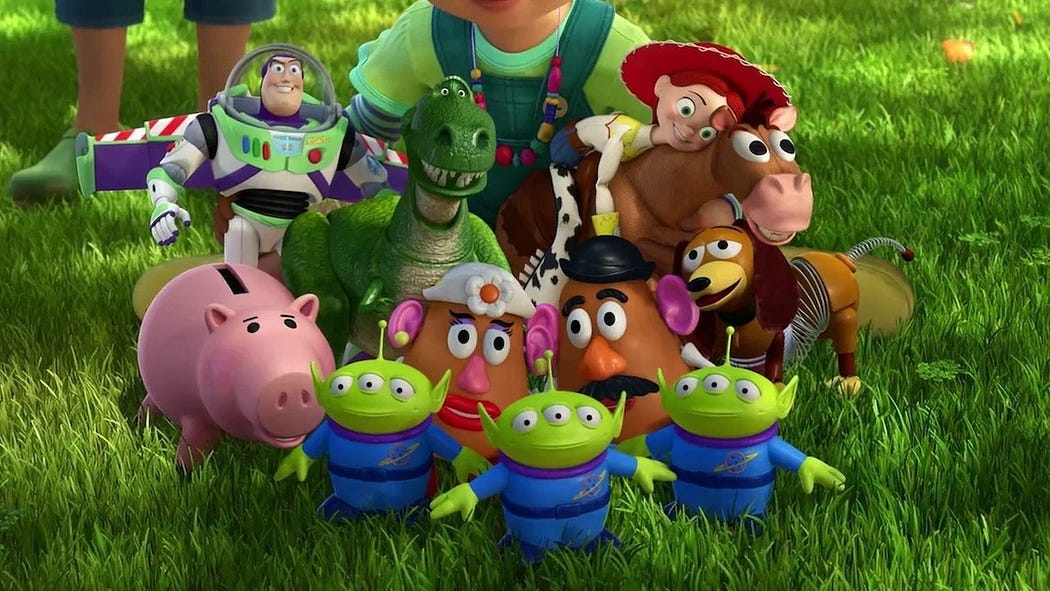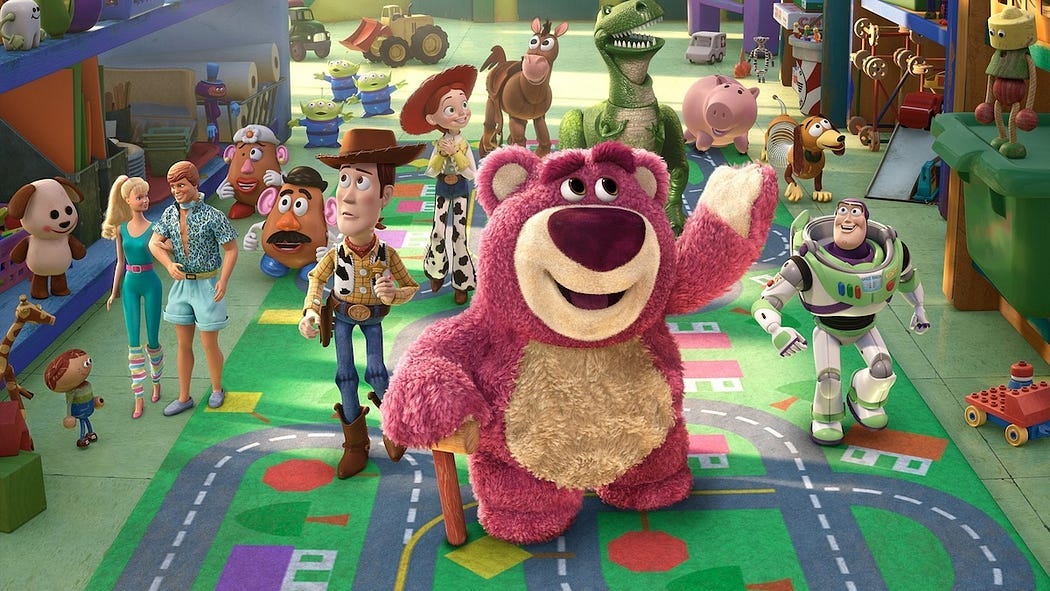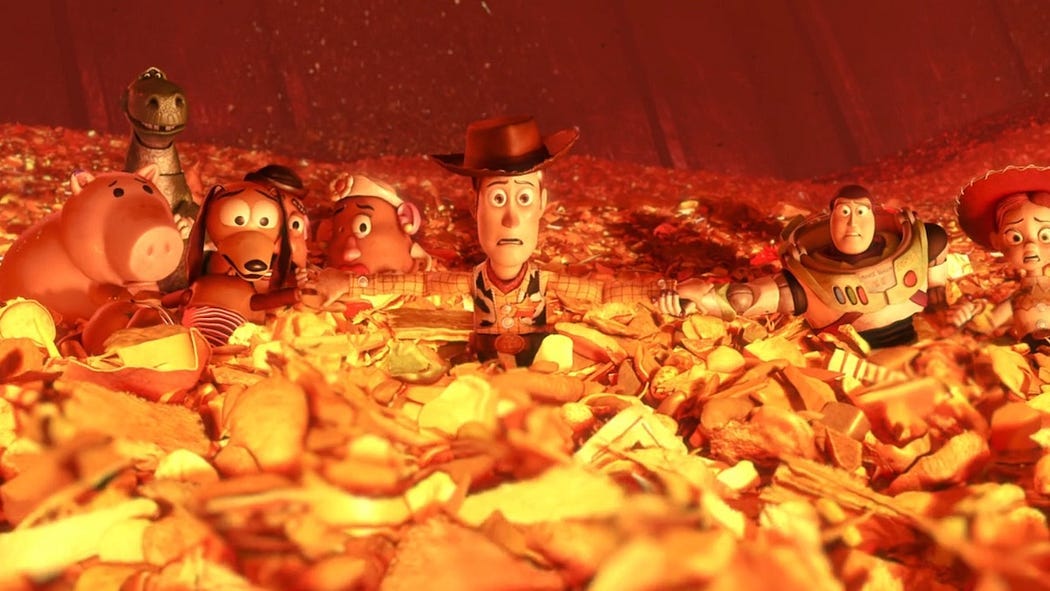Toy Story 3 (2010) • 15 Years Later — beautiful, bittersweet, and hilarious ode to growing up and moving on
The toys are mistakenly delivered to a day-care centre instead of the attic right before Andy leaves for college…
It’s remarkable how shoddy a toy’s life seems in Pixar’s Toy Story films (which, unfortunately, can no longer be referred to as a trilogy). Toys lie in wait for their beloved owners to play with them, whereby they slacken their bodies, turn into mutes, and resign themselves to whatever form of playtime these kids devise. The options may be endless thanks to children’s limitless imaginations, but what remains unchanged is how these toys wordlessly accept whatever is asked of them. Over the years, they will be gradually forgotten about, cast aside for different items that preoccupy their beloved owner’s attention. Then it’s off to the garbage dump, unloved and without a purpose.
And those are the lucky ones. You could be abandoned and forgotten about long before your beloved owner reaches adulthood, like Jessie (Joan Cusack), whose recounting of her neglect in Toy Story 2 (1999) is a surprisingly poignant moment for a children’s animated film. The fear of abandonment is a paralysing one, especially when it involves beings that long to live in the service of a revered owner. To be ignored is a confirmation of their worthlessness. These toys are like needy dogs, desperate for affection and love, terrified that these things will be taken from them at any moment.
It’s no wonder that abandonment issues make some of these characters bitter and hard-hearted, like Lotso (Ned Beatty), the cuddly-looking purple teddy bear at Sunnyside Daycare, the place where Andy’s (John Morris) toys end up after he gets ready to leave home for college. Of course, this wasn’t Andy’s plan, with this rehashing of the confusion between Andy’s intentions and his toys’ interpretations of them being as indebted to previous films as Lotso’s villainous reveal (his character is a noticeable retread of Kelsey Grammer’s Stinky Pete from Toy Story 2). Somehow, this familiar narrative ground is still emotive, and not just because this is a children’s film, where it’s easier to get away with repetitive plot beats and character motivations between films.

Lotso’s tragic backstory doesn’t just rival the heartbreak of Jessie’s abandonment issues from the second movie, it once again illustrates the emotional maturity of the film series, which continually builds on its thematic resonance to do justice to depicting the lives of toys that will live for far longer than how long their owners will care for them. Toy Story 3’s time jump to Andy reaching adulthood underscores the fragility of these characters’ existence and and the constant insecurities this brings up. Years of enjoyment can pass by in what feels like a fraction of that time, but even a single spent in abandonment seems like an eternal torture. The tone of the second film soars given its whimsical tone, making for the most fun entry in the franchise, but in hindsight it feels that this plot development was the only possible way this series could have concluded (unfortunately, it hasn’t ended there, but let’s ignore that unwelcome change for a moment).
Lotso might put on a pleasant front, but he’s possibly the most sinister character in the entire franchise, his malevolent traits stemming from being accidentally left behind on a family trip by his beloved owner Daisy, then replaced. Lotso’s importance in Daisy’s life caused her parents to buy her a replacement of the toy, unlike the two other toys who are left behind, Big Baby (Woody Smith) and Chuckles (Bud Luckey). His importance in Daisy’s life is what led to him learning how disposable he is. It’s devastating enough to shatter Lotso’s faith in humanity, as well as any semblance of positive traits, heralding a transformation into the most iconic and pitiful villain in this franchise.

Thankfully, Toy Story 3’s comedic chops are also on top form to balance out a surprisingly dark entry in this franchise. Ken (Michael Keaton) is a welcome addition to this cast, with the flamboyant and wonderfully narcissistic minor antagonist forced to battle his greed and ego when he falls head over heels in love with Barbie (Jodi Benson). Keaton manages to make Ken oddly sympathetic in spite of his pathetic, delusional qualities. Javier Fernández Peña also deserves acclaim as a new cast member, voicing Buzz Lightyear’s (Tim Allen) Spanish mode, one of the film’s most enjoyable elements. Beatty is tasked with delivering the most emotive vocal performance of the entire cast, with a warm and rich voice to mark him out as an old and wise bear amongst the group, but which stirs with unbridled fury once his role as Toy Story 3’s overarching villain emerges.
The regular cast are phenomenal, but that should be no surprise; they’ve always been on top form, even in the mistake in movie form that is Toy Story 4 (2019). Sans the fourth instalment (and the fifth film in the franchise, which is due to be released in summer 2026), this franchise puts so much care into each of its characters that there’s no mistaking its heart. It’s also something of a miracle that a film series can produce a third movie over ten years after its predecessor and demonstrate that time has done nothing to dull its joy and emotional investment. Director Lee Unkrich took the reins seamlessly from John Lasseter, the former chief creative officer at Pixar, who directed the franchise’s first two films. Whether it’s in the animation (especially the sequences prioritising Ken), screenplay (penned by Michael Arndt), or voice acting, Toy Story 3 is a masterpiece of children’s animation.

A consistent hallmark of these films is how impossibly large the world appears to toys. Oftentimes this is manifested in madcap adventures or break-out missions, where these plastic figures must overcome everyday items of the regular world, which are transformed into formidable obstacles for our tiny heroes. But these toys are also dwarfed by the passage of time. The Toy Story films usually take place over the course of a few days, yet it feels as if they encompass epic journeys (especially given this third outing’s fantastic, spirited ending). These are true underdog stories, with characters that appear hopelessly lost whenever their owner is not there to protect them, yet who succeed despite all the odds being stacked against them in a cruel, cynical, greedy, and giant world that’s always threatening to engulf them completely.
So it’s only right that the power of their shared bond, and the countless times it has helped them evade danger, death, disrepair and isolation, should be the uniting force that allows them to succeed even without their beloved Andy in their lives. It’s not often that one can forget about clichés or expectations in children’s films, especially for their endings, which almost always have to have a feel-good element to them. Great films can subvert these expectations, but again, out-of-the-box thinking in filmmaking doesn’t exactly mesh well with kids’ expectations or Disney’s profit motive. But in that moment where these beloved characters lie within the belly of the beast in an incinerator, fully accepting their fate and secure in the knowledge that what they always needed most was each other, Toy Story 3 is able to transcend these expectations and make one forget that Pixar would never commit to such a gutsy ending.
Then, the film does something equally brilliant with a final scene that is warm, rich, and never saccharine, leaving these toys in good hands with just enough of a bittersweet feeling to make it a worthy resolution to this trilogy. It might not be a very original experience (especially if you rewatch the films within days of one another), but Toy Story 3 is a moving and heartwarming film that builds on its established themes wonderfully. With this in mind, it’s no small feat that the film series’ fourth instalment is able to meaningfully develop the franchise’s themes of abandonment, reminiscence, and learning to grow up and move on in life. That said, while Toy Story 4 is by no means a bad film (and the same could even be the case for the upcoming fifth feature), it’s a completely unnecessary one. It’s very, very rare that a good film should not be made, and this is one of those rare occasions, with the series’ third film providing a moving conclusion to one of the finest film trilogies in the history of animation.
USA | 2010 | 103 MINUTES | 1.78:1 | COLOUR | ENGLISH • SPANISH
Cast & Crew
director: Lee Unkrich.
writer: Michael Arndt (story by John Lasseter, Andrew Stanton & Lee Unkrich).
voices: Tom Hanks, Tim Allen, Joan Cusack, Ned Beatty, Michael Keaton, Don Rickles, Wallace Shawn, John Ratzenberger, John Morris, Jodi Benson, Estelle Harris, Javier Fernández Peña & Charlie Bright.
Originally published at https://www.framerated.co.uk on June 14, 2025. All images are used according to the Fair Use doctrine in US & UK law for review, commentary, and education.










